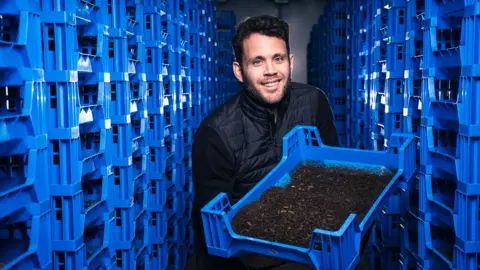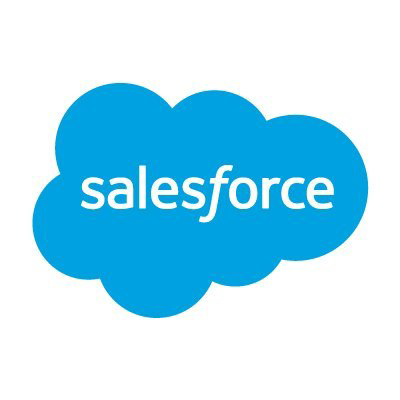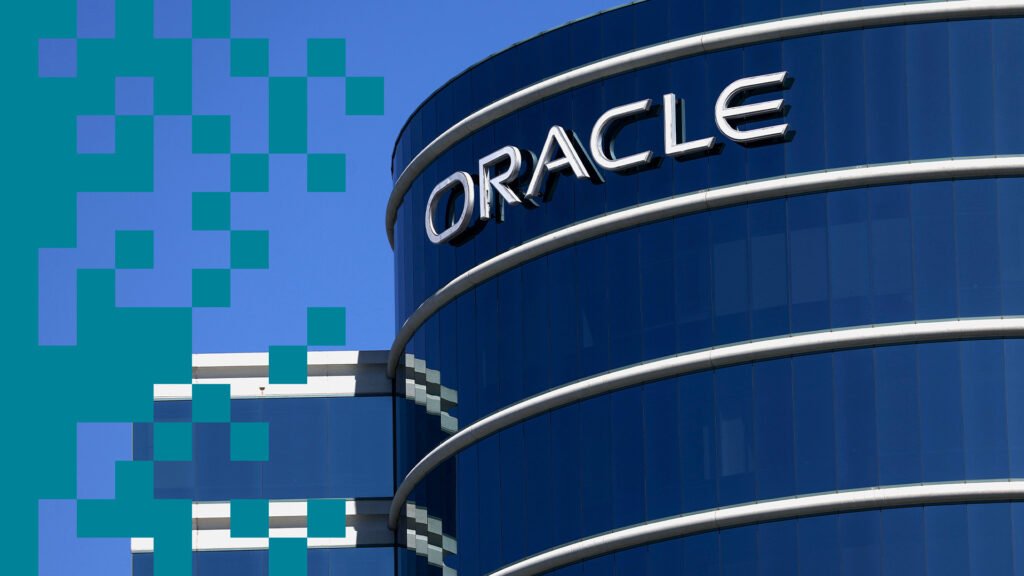AI Insights
Should we be letting flies eat our food waste?

Technology Reporter
 Energesman
EnergesmanMost people are inclined to shoo flies away from food, and the thought of maggots in your bins is enough to make anyone’s stomach turn.
But a handful of city councils have embraced maggots – more formally known as fly larvae – and their taste for rotting food.
In Vilnius, capital of the Baltic state of Lithuania, fly larvae have officially been given the job of processing the 2,700 tonnes of food waste the city’s 607,000 residents put out for collection each year, alongside that of the six neighbouring councils.
Energesman, the waste management company that began relieving Vilnius of its food waste earlier this year, doesn’t actually charge the city for this service.
That is saving the city up to €2m (£1.7m; $2.3m) per year, based on a target of processing 12,000 tonnes in 2026 says the company’s chief executive, Algirda Blazgys.
Energesman has rolled out new orange food waste bags to residents, alongside an influencer marketing campaign to encourage more Vilniečiai to separate their food waste, as the 2,700 tonnes collected is only a fraction of the 40,000 tonnes of household waste the city is thought to generate.
Last year it become mandatory for councils to collect food waste, so the city needs to find ways to deal with it.
Energesman, meanwhile, has plans to turn the fattened fly larvae into a new income stream.
It houses around six million flies in a special zone within its Vilnius plant, who mate around every six hours, according to CEO Algirdas Blazgys.
A female fly can lay around 500 eggs in her average 21-day lifespan, so Mr Blazgys and his team are dealing with more than three million larvae a month, who can consume more than 11 tonnes of food waste in the first, hungriest days of their lives.
 Energesman
EnergesmanIt’s the huge appetites of these tiny creatures that make them such excellent candidates for food waste processing. This study shows a swarm of them demolishing a 16 inch pizza in just two hours.
The trick is to cull them before they transform into mature flies. That way the protein rich fly larvae can be converted into protein products for use in animal feed or industrial use, for example as an ingredient in paint, glue, lamp shades and furniture covers.
Also, their manure, known as frass, can be used as fertiliser.
Energesman has already set up supply trials with partners in the paint, glue and furniture industries, but Mr Blazgys acknowledges it’s proving more complicated than he anticipated.
The sample paint produced using Energesman-reared fly larvae didn’t quite come out in the right colour, but the lamp shades created look promising.
He also has university partnerships in place to supply fly larvae for research purposes and for feeding bacteria. And of course, the larvae are in demand from the local fishing industry to use as bait.
But EU health and safety regulations mean fly larvae fed with kitchen waste can’t be used in edible insect products for human consumption, as there could be cross contamination from meat and fish scraps.
“We came up with some crazy ideas, then we started looking for other people that could also come with some crazy ideas about what we could do,” says Mr Blazgys.
“As it’s still very new, some people are still looking to see if we’re going to fail, so they don’t want to brag about it yet. But I think we’re going to come up with something good.”
While there are numerous cases around the world of fly larvae being used in food waste management, and being harvested as a protein ingredient, it’s largely on a commercial basis, for example, a private contract between a hotel or apartment building owner and a fly larvae rearer.
In Kenya, Project Mila is a social enterprise using fly larvae to tackle Mombasa’s mounting food waste problem, while also supplying frass as fertiliser to local farmers.
Yet there are just a handful of city councils that have adopted this way of processing food waste.
Goterra in Australia has used fly larvae to help Sydney get through its food waste, as part of a limited trial which began this year.
For the past three years, Goterra has also been working with three townships that are part of the neighbouring Queanbeyan-Palerang Regional Council, recycling around 10 tonnes of food waste.
 Flybox
FlyboxWhether we will see UK councils start shipping in millions of flies, so their larvae can munch through the 6.4 million tonnes of household food waste produced here yearly, is only a matter of time.
That’s the optimistic view of Larry Kotch. He’s the CEO and co-founder of insect waste management company Flybox, which he says builds more insect waste processing sites than any other company in the UK, which then work largely with private food manufacturers and supermarkets.
Flybox is also a founding member of the Insect Bioconversion Association, an industry body representing companies in the space.
UK councils are interested, Mr Kotch believes, especially because weekly household food waste collections will become mandatory in England from March 2026.
Around 148 of England’s 317 local authorities still don’t offer this, according to the Local Authority Recycling Advisory Committee.
 Flybox
FlyboxBut regulations set by the Department for Environment, Food and Rural Affairs (DEFRA) are currently barring councils from using fly larvae to process food waste.
If regulation could move in line with science, Mr Kotch argues that “the UK could see its first council-contracted insect plant within two years”.
“Unfortunately, with government it’s always safer to say no… Everyone we’ve spoken to in UK councils are very excited about insect protein and would much rather work with insect farms than alternative technologies.”
DEFRA confirmed to the BBC that the Animal By-Product Regulations restrict insects from being used to process organic waste streams.
It says there are currently no plans to review these regulations. “Our waste management regulations play a crucial role in protecting UK biosecurity and reducing the risk of disease,” the spokesperson said.
The current alternative for sending food waste to landfill is anaerobic digestion (AD), a breakdown process which creates biogas.
However, Mr Kotch says current AD plants aren’t enough to cope with the anticipated influx of household food waste.
“Globally, over 1.3 billion tonnes of food is wasted every year. We believe up to 40% of that could be upcycled using insect waste management. And not only does it avoid disposal costs and methane emissions, but it also produces valuable protein and organic fertiliser,” says Mr Kotch.
AI Insights
Oracle’s AI strategy to take on Epic – statnews.com
AI Insights
Building industrial AI from the inside out for a stronger digital core

A manufacturer was running an AI training workload on a cobbled together system of GPUs, storage, and switching infrastructure, believing it had all the necessary tech to achieve its goals. But the company had put little thought into how the components actually worked together.
Problems surfaced quickly. Training cycles dragged on for days instead of hours. Expensive hardware sat idle. And engineering teams began to wonder whether their AI investment would ever pay off.
This experience isn’t unique. As AI becomes a critical element of industrial operations worldwide, many organizations are discovering a counterintuitive truth: the biggest breakthroughs come not from piling on more GPUs or larger models, but from carefully engineering the entire infrastructure to work as a single, integrated system.
Engineering for outcomes
What became of that cobbled-together system? When it was properly engineered to balance compute, networking, and storage, the improvement was quick and dramatic, explains Jason Hardy, CTO of AI for Hitachi Vantara: a 20x boost in output and a matching reduction in “wall clock time,” the actual time it takes to complete AI training cycles.
“The infrastructure must be engineered so you understand exactly what each component delivers,” Hardy explains. “You want to know how the GPU drives specific outcomes, how that impacts the data requirements, and demands on throughput and bandwidth.”
Getting systems to run that smoothly means confronting a challenge most organizations would rather avoid: aging infrastructure.
Hardy points to a semiconductor manufacturer whose systems performed fine—until AI entered the picture. “As soon as they threw AI on top of it, just reading the data out of those systems brought everything to a halt,” he says.
This scenario reflects a widespread industrial reality. Manufacturing environments often rely on systems that have been running reliably for years, even decades. “The only places I can think of where Windows 95 still exists and is used daily are in manufacturing,” Hardy says. “These lines have been operational for decades.”
That longevity now collides with new demands: industrial AI requires exponentially more data throughput than traditional enterprise applications, and legacy systems simply can’t keep up. The challenge creates a fundamental mismatch between aspirations and capabilities.
“We have this transformational outcome we want to pursue,” Hardy explains. “We have these laggard technologies that were good enough before, but now we need a little bit more from them.”
From real-time requirements to sovereign AI
In industrial AI, performance demands often make enterprise workloads look leisurely. Hardy describes a visual inspection system for a manufacturer in Asia that relied entirely on real-time image analysis for quality and cost control. “They wanted AI for quality control and to improve yield, while also controlling costs,” he says.
The AI had to process high-resolution images at production speed—no delays, no cloud roundtrips. The system doesn’t just flag defects but traces them to the upstream machine causing the problem, enabling immediate repairs. It can also salvage partially damaged products by dynamically rerouting them for alternate uses, reducing waste while maintaining yield.
All of this happens in real-time while collecting telemetry to continuously retrain the models, turning what had been a waste problem into an optimization advantage that improves over time.
Using the cloud exclusively introduces delays that make near-real-time processing impossible, Hardy says. The latency from sending data to remote servers and waiting for results back can’t meet manufacturing’s millisecond requirements.
Hardy advocates a hybrid approach: design infrastructure with an on-premises mindset for mission-critical, real-time tasks, and leverage the cloud for burst capacity, development, and non-latency-sensitive cloud-friendly workloads. The approach also serves the rising need for sovereign AI solutions. Sovereign AI ensures that mission-critical AI systems and data remain within national borders for regulatory and cultural compliance. As Hardy says, countries like Saudi Arabia are investing heavily in bringing AI assets in-country to maintain sovereignty, while India is building language- and culture-specific models to accurately reflect its thousands of spoken languages and microcultures.
AI infrastructure is more than muscle
Such high-level performance requires more than just fast hardware. It calls for an engineering mindset that starts with the desired outcome and data sources. As Hardy puts it, “You should step back and not just say, ‘You need a million dollars’ worth of GPUs.’” He notes that sometimes, “85% readiness is sufficient,” emphasizing practicality over perfection.
From there, the emphasis shifts to disciplined, cost-conscious design. “Think about it this way,” Hardy says. “If an AI project were coming out of your own budget, how much would you be willing to spend to solve the problem? Then engineer based on that realistic assessment.”
This mindset forces discipline and optimization. The approach works because it considers both the industrial side (operational requirements) and the IT side (technical optimization)—a combination he says is rare.
Hardy’s observations align with recent academic research on hybrid computing architectures in industrial settings. A 2024 study in the Journal of Technology, Informatics and Engineering1 found that engineered CPU/GPU systems achieved 88.3% accuracy while using less energy than GPU-only setups, confirming the benefits of an engineering approach.
The financial impact of getting infrastructure wrong can be substantial. Hardy notes that organizations have traditionally overspend on GPU resources that sit idle much of the time, while missing the performance gains that come from proper system engineering. “The traditional approach of buying a pool of GPU resources brings a lot of waste,” Hardy says. “The infrastructure-first approach eliminates this inefficiency while delivering superior results.”
Avoiding mission-critical mistakes
In industrial AI, mistakes can be catastrophic—faulty rail switches, conveyors without emergency shutoffs, or failing equipment can injure people or stop production. “We have an ethical bias to ensure everything we do in the industrial complex is 100% accurate—every decision has critical stakes,” Hardy says.
This commitment shapes Hitachi’s approach: redundant systems, fail-safes, and cautious rollouts ensure reliability takes precedence over speed. “It does not move at the speed of light for a reason,” Hardy explains.
The stakes help explain why Hardy takes a pragmatic view of AI project success rates. “Though 80-90% of AI projects never go to production, the ones that do can justify the entire effort,” he says. “Not doing anything is not an option. We have to move forward and innovate.”
For more on engineering systems for balanced and optimum AI performance, see AI Analytics Platform | Hitachi IQ
Jason Hardy is CTO of AI for Hitachi Vantara, a company specializing in data-driven AI solutions. The company’s Hitachi iQ platform, a scalable and high-performance turn-key solution, plays a critical role in enabling infrastructure that balances compute, networking, and storage to meet the demanding needs of enterprise and industrial AI.
AI Insights
A Platform Leader’s Path to Sustained Dominance

This article first appeared on GuruFocus.
Salesforce (NYSE: CRM) offers a compelling long-term opportunity due to its leadership in the customer relationship management (NYSE:CRM) market, expanding AI integration, and growing addressable market. because of its continuous leading position in the customer relationship management (NYSE:CRM) market, the fast-growing adoption of artificial intelligence, and rapidly increasing the total addressable market. The business model that the company provides allows subscriptions and grants profits that are predictable, moreover, the platform-based approach increases the switching costs and provides opportunities to expand within the existing client bases. Thus, theThe business model enables high visibility into recurring revenue and long-term client retention.
Standing at the forefront of the global CRM market, Salesforce has captured nearly a quarter (23%) of the market share, leaving behind formidable adversaries like Microsoft, Oracle, and SAP. The position of being number one provides Salesforce with a multilayer competitive fortifications; thus, it builds a strong economic moat.
Network Effects and Ecosystem Dominance: There are over 4,000 applications on the AppExchange belonging to the Salesforce ecosystem, reinforcing its self-expanding cycle where developers attract customers, and vice versa. This network effect, which grows stronger with the addition of new applications thus the ecosystem expands, creates a barrier to entry that competitors find it almost impossible to duplicate. Independent software vendors (ISVs) devote a large amount of time and energy in creating applications that work with Salesforce, which in turn, makes the customers think that if they switch to another platform they would be missing out on the benefits of the whole partner network.
Data Network Effects: The greater the number of customers availing of Salesforce services, the larger is the amount of the data which is being accumulated by the platform on customer interactions across different sectors and applications. This data facilitates the enhancement of AI models, predictive analytics, and benchmarking capabilities; thus, the platform continues to generate value that compounds over the years and is not easily reproduced by new entrants.
Salesforce’s artificial intelligence strategy is a key component not just because it adds features, Salealos because sforce’s artificial intelligence strategy enhances its platform differentiation and supports operational leverage.. The company introduces the next generation of AI technology and improves the algorithmic base inspiring the organizations to work different with the which they produce and hold about their own customer data.
-

 Business2 weeks ago
Business2 weeks agoThe Guardian view on Trump and the Fed: independence is no substitute for accountability | Editorial
-
Tools & Platforms4 weeks ago
Building Trust in Military AI Starts with Opening the Black Box – War on the Rocks
-

 Ethics & Policy1 month ago
Ethics & Policy1 month agoSDAIA Supports Saudi Arabia’s Leadership in Shaping Global AI Ethics, Policy, and Research – وكالة الأنباء السعودية
-

 Events & Conferences4 months ago
Events & Conferences4 months agoJourney to 1000 models: Scaling Instagram’s recommendation system
-

 Jobs & Careers2 months ago
Jobs & Careers2 months agoMumbai-based Perplexity Alternative Has 60k+ Users Without Funding
-

 Podcasts & Talks2 months ago
Podcasts & Talks2 months agoHappy 4th of July! 🎆 Made with Veo 3 in Gemini
-

 Education2 months ago
Education2 months agoMacron says UK and France have duty to tackle illegal migration ‘with humanity, solidarity and firmness’ – UK politics live | Politics
-

 Education2 months ago
Education2 months agoVEX Robotics launches AI-powered classroom robotics system
-

 Funding & Business2 months ago
Funding & Business2 months agoKayak and Expedia race to build AI travel agents that turn social posts into itineraries
-

 Podcasts & Talks2 months ago
Podcasts & Talks2 months agoOpenAI 🤝 @teamganassi



